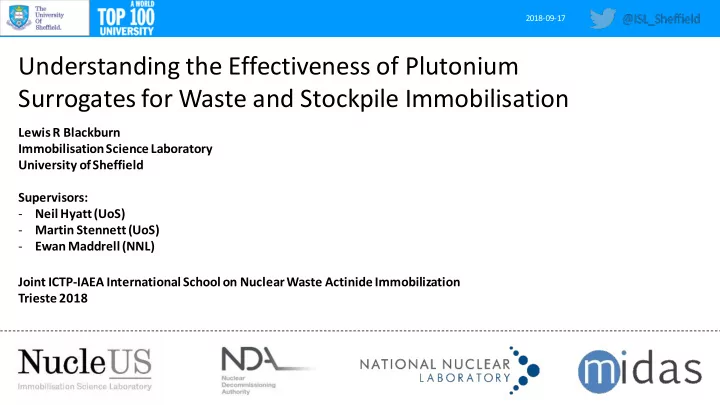

2018-09-17 Understanding the Effectiveness of Plutonium Surrogates for Waste and Stockpile Immobilisation Lewis R Blackburn Immobilisation Science Laboratory University of Sheffield Supervisors: - Neil Hyatt (UoS) - Martin Stennett(UoS) - Ewan Maddrell(NNL) Joint ICTP-IAEA International School on Nuclear Waste Actinide Immobilization Trieste 2018
Radioactive Waste in the United Kingdom
United Kingdom Plutonium Stocks • The United Kingdom reprocesses spent nuclear fuel into reusable components via PUREX separations, this takes place at ThORP (Thermal Oxide Reprocessing Plant), Sellafield. • Reprocessing will cease in 2018; UK plutonium stocks are predicted to reach 140 teHM (largest non-military stockpile worldwide. • The Nuclear Decommissioning Authority (NDA) is liable for the stockpile and is in the process of refining several credible options for long term management.
Dual Track Strategy ≈ • Almost 40 t of separated plutonium left without disposition route • Comparisons between UK and US positions • Indicates MOX based strategy might not be sustainable or achievable MOX + MOX Fuel Fabrication Facility Immobilisation Dual Track Strategy: • $4,000,000,000 and 50% complete • MFFF Immobilisation Immobilisation and disposal to spearhead • Cost and schedule overruns policy • Inadequate assumptions of • Regressions to MOX programme would not labour and equipment MFFF strand the Pu without disposition route • Projected to cost around • “ any remaining plutonium which is not $30,000,000,000 converted to MOX, or otherwise reused, will • ‘ Stranded Plutonium ’ be immobilised and treated as waste for disposal. ”
The Use of Surrogates The use of surrogates/simulants is common: SURROGATE HEIRARCHY • Most widely used • Lanthanide A • Cheap T T • E Most similar to Pu • N Radiotoxic • T Handling requirements I O • N Actinide • Least studied • Gap in knowledge? • Some elements are costly and radioactive No element can successfully provide • Stringent requirements for Pu manipulation a full suite of behaviours from which true mimicking can occur • Specialist equipment and risk to workers
CaZrTi 2 O 7 Zirconolite • Candidate phase for plutonium retention: Synroc-C • Demonstrated aqueous durability • Natural analogues Waste ions can partition onto both Zr 4+ and Ca 2+ sites • • Polytypic behaviour (2M, 4M, 3T etc.)
Experimental Aims and Methods • Compare relative behaviour of plutonium surrogates Ce, U, Th, by incorporation into zirconolite lattice • Synthesised materials characterised by XRD, SEM, EDX, XAS Dried precursors Green bodies CaTiO 3 , ZrO 2 , Fritsch pressed sintered in air at Retain ceramic TiO 2 , CeO 2 , Planetary-Mill: uniaxially into range of and characterise ThO 2 , UO 2 500rpm, 5min pellets temperatures
CaZr 1-x Ce x Ti 2 O 7 – 1300 o C, 8 h
CaZr 1-x Ce x Ti 2 O 7 – 1300 o C, 8 h
CaZr 0.6 Ce 0.4 Ti 2 O 7 – 12 h
XRD – CaZr 1-x U x Ti 2 O 7
XAS – CaZr 1-x U x Ti 2 O 7
XRD – CaZr 1-x Th x Ti 2 O 7
Hot Isostatic Pressing: CaZr 1-x Ce x Ti 2 O 7. x = 0.1, 0.2, 0.3, 0.4 Fritsch HIP: 10 o C/min 55g batch: Planetary- Evacuation + Retain 600 o C 12h CaTiO 3 , ZrO 2 , 300 o 14h ceramic and Mill: ramp, calcine TiO 2 , CeO 2 bake-out 1200 o C, characterise 500rpm, 10min 100MPa, 4h
Hot Isostatic Pressing: CaZr 1-x Ce x Ti 2 O 7. x = 0.1, 0.2, 0.3, 0.4 Can Densification Number (internal) % 1 43 2 44 3 43 4 42
SEM – HIPed CaZr 0.6 Ce 0.4 Ti 2 O 7 ZRC P Z C T • • ZC – zirconolite XRD confirms phase assemblage • • C – cerium Ceria likely unreacted material • • P – perovskite Perovskite and zirconia could have formed but also possibility of unreacted calcium titanateand • T – rutile zirconium oxide • • Z - zirconia Optimisation of pre-processing parameters or possibly higher reaction temperature needed
Concluding Remarks • Substantial differences in plutonium surrogate behaviour has been identified • Traditional sintering in oxidising atmosphere leads to pronounced changes in phase assemblage • The propensity of cerium to reduce leads to formation of secondary phases, highly undesirable for plutonium immobilisation • The potential of uranium to form higher oxidation states than applicable for plutonium indicates that its use as a surrogate is highly dependent on processing atmosphere • The refractory nature of ThO2 in comparison to CeO2 and UO2 implies its use as a simulant for PuO2 is sensitive to processing conditions • Large cerium oxide inclusions leads to conclusion that optimisation of pre-processing parameters for HIP is needed
Thank you for listening – any questions?
Recommend
More recommend